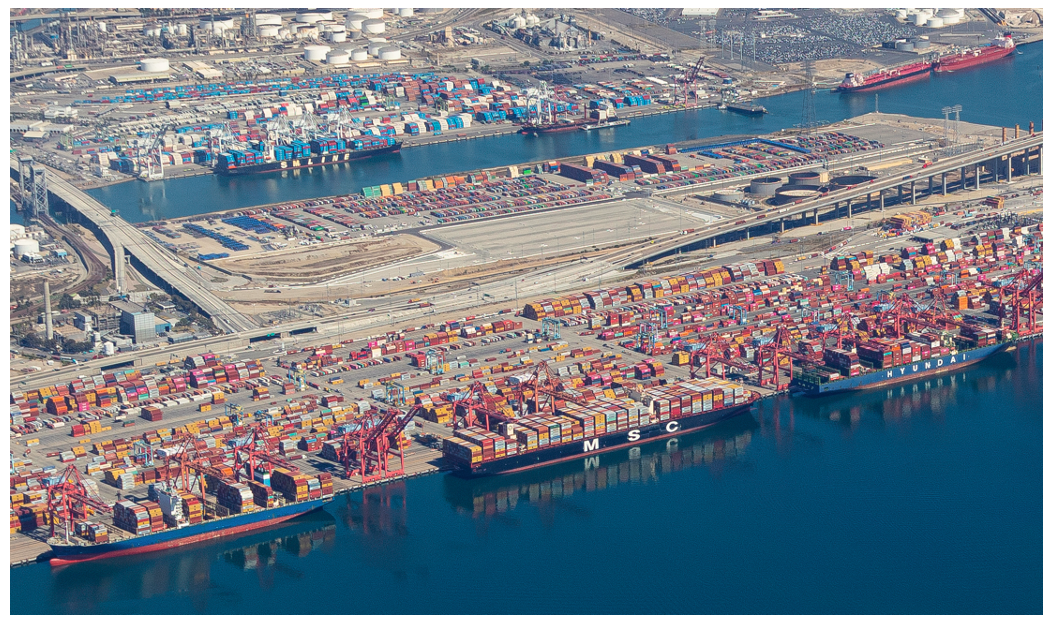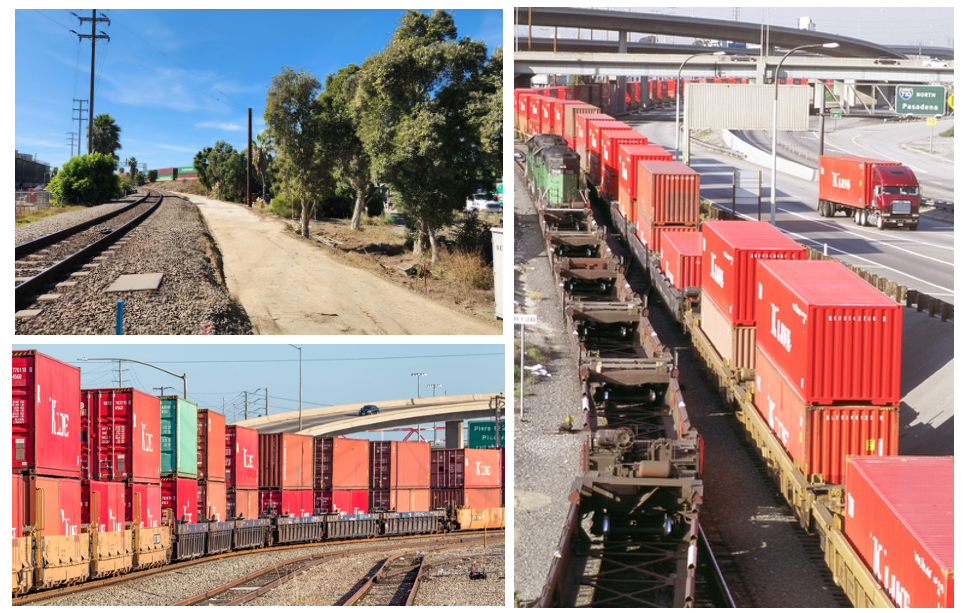
Aerial view of the Port of Long Beach, which together with the Port of Los Angeles makes up the busiest port complex in North America. Credit POLB.
The Port of Long Beach plans to dramatically increase the amount of cargo moved by ondock rail with this project, a move towards sustainability four-times more fuel-efficient than truck transport. This project will reduce train idling and allow the staging of up to 12,000 foot-long trains. That will potentially offset 2.2 million truck trips between project completion in 2024 and the year 2035.
“In this, our ‘Year of Rail,’ the Port of Long Beach is honored to receive the Envision Verified Award from the Institute for Sustainable Infrastructure for our Terminal Island Wye Rail Project. This crucial project – currently under construction – is designed to enhance the efficiency of cargo flow through the San Pedro Bay ports complex,” said Mario Cordero, Port of Long Beach CEO. “This is one more example of the Port’s dedication to strengthening its competitiveness though sustainable development.”
“Congratulations to Port of Long Beach and the entire project team on the success of this project,” said Kristi Wamstad, ISI’s Verification Director. “The Terminal Island Wye Track Realignment Project stimulates economic prosperity by creating local jobs, improves community quality of life measures, and contributes to regional climate and resiliency goals.”
THE PROJECT IN BRIEF
The recipient of grant funding through U.S. DoT’s Better Utilizing Investments to Leverage Development (BUILD) grant program, this is a $40-million project exclusively for facilitating freight movement and the assembly of trains which move freight. The creation of jobs and the impact on economic livelihoods (locally and nationally) will be significant in that this project addresses freight congestion challenges along the San Pedro Bay (SPB) rail network, with emphasis on Terminal Island. The island is home to significant port operations of the Port of Long Beach and the Port of Los Angeles, which comprise the busiest port complex in North America.
The project will realign the existing track and add an adjacent 5,000-foot track that will connect the west end of the Terminal Island Wye to the east end of the Total Terminals International facility. The new track will allow trains to be built on Terminal Island without blocking and interfering with rail access and movements at Pier T East terminals and would involve installation of new track inside a working terminal.
Parallel to the two tracks, two 2,000-foot siding tracks will be constructed — storage tracks that can be used in lieu of tracks north of the Badger Avenue Bridge. This will provide important safety improvements.

The Terminal Island Wye Rail Project addresses freight congestion challenges along the San Pedro Bay (SPB) rail network, with emphasis on Terminal Island. Credit POLB.
VERIFIED SUSTAINABILITY ACHIEVEMENTS
Infrastructure Integration: The project contributes to the beneficial integration of multiple infrastructure systems. By removing a major rail bottleneck and adding key improvements to the rail system, locomotive idling will be reduced by 2,500 hours annually. The project delivers on strategic long-term goals like reducing truck traffic and congestion, speeding cargo shipped by on-dock rail, and minimizing constraints that hamper cargo volumes.
Stimulating economic prosperity: Delayed train moves that occur when several terminals compete to use the single existing track for different operations will be eliminated by adding the new 5,000-foot track. Freight-related congestion will be reduced in Southern California. A key outcome will be better travel times and an improved flow of goods to local and national markets.
Committed to stakeholder engagement: As highlighted in Envision, communication and interactions with community stakeholders are essential to reaffirm and improve the project objectives. Stakeholder activities were carried out in alignment with the Port of Long Beach, Port Master Plan and the Port of Long Beach Strategic Plan. The project team demonstrated that it works closely with community stakeholders to identify and assess potential social impacts. The entire project is also supported by the San Pedro Bay Ports Clean Air Action Plan and the Los Angeles and Long Beach Rail Study, which demonstrate the importance of rail to environmental and community objectives.
Protect Surface and Groundwater Quality: The project will identify locations for storage of hazardous materials during construction as well as BMPs, notifications, and cleanup requirements for incidental spills or other potential releases of hazardous materials. Strict inspection, monitoring, and reporting requirements will need to be implemented and maintained during construction. The project will establish sediment basins and inspecting areas and impose requirements on safe unloading and safe storage of materials at the highest standards.
Regional air quality: Project data indicates that the work will reduce CO2 emissions by approximately 65%. It is expected that this project will result in NOx emission reductions 4.2 tpy for the 2035 operational year. Emission reductions can be attributed to the assumption that locomotive activity would be reduced by 2,500 hours annually, as set out in the project’s NEPA Environmental Assessment.
Climate and Resilience: In terms of assessing climate change vulnerability, the project area was analyzed within the Port’s Climate Adaptation and Coastal Resiliency Plan and the analysis details the effects of sea level rise within the project area, and the entire port area, as well as priorities and projects recommended as a response.
PROJECT DETAILS AT-A-GLANCE
Envision-verified project: Terminal Island Wye Track Realignment Project
Location: Port of Long Beach, Calif.
Lead Envision Firm: Owner-led verification
Envision Rating: Verified
Award Date: March 21, 2024
Total Cost of Project: $40 million
Project Owner: Port of Long Beach
Project Partners: PacRim Engineering, Jacobs, Earth Mechanics, Pacific Railway Enterprises, Lynn Capouya Landscape Architect, Herzog Stacy & Witbeck, Churchill, Skanska, Burns & McDonnell, Verdical Group
Project Phase: Construction
Project Delivery Method: Design-Bid-Build



